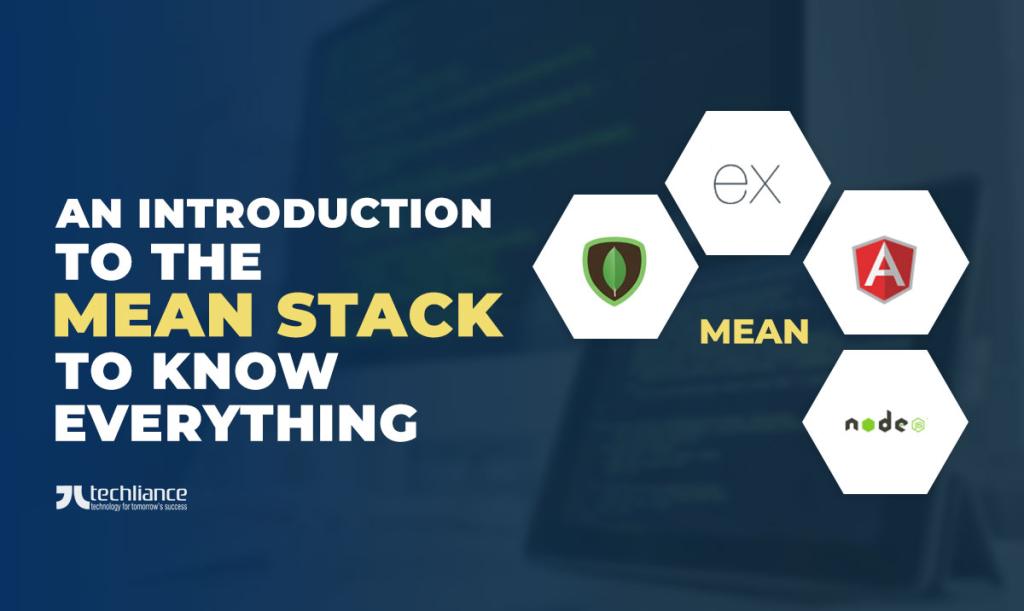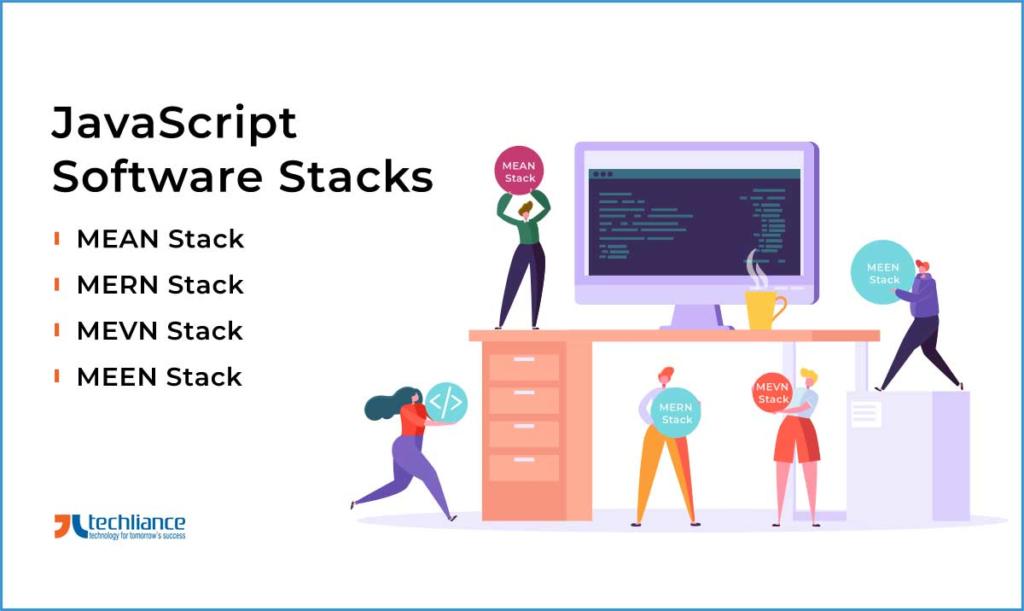People believe that being “mean” is not a good trait to possess. When it comes to the MEAN stack, it is a great thing to have a command of. It is powering many web apps and websites during 2023.
MEAN stack remains immensely popular among developers as well as businesses worldwide and in the USA. As both prefer to develop dynamic and performant web applications in the MEAN stack centered on Angular. The concept of the MEAN stack came to the fore 10 years ago.
Since then, it has been widely accepted and adapted across the industry. This post entirely covers the MEAN stack and its different aspects. So, let’s take a close look at it.

What is the MEAN Stack?
Arguably, the most popular development environment globally is the MEAN stack. It comprises MongoDB, ExpressJS, Angular, and NodeJS. This powerful full-stack JavaScript toolset is suitable for building many types of web-centric applications.
MEAN stack is fully JS-driven, and is widely popular for creating both web applications and cloud-centric solutions. Although the name seems extremely peculiar, there is nothing “mean” about the development stack. It’s general information that the stack name comes from a handful of JavaScript technologies.
Which technologies make up the MEAN Stack?
First-of-all, here MEAN is an acronym for the four technologies that are its members. Realize that these technologies are JavaScript-driven. Here is what each letter stands for in the MEAN stack.
- MongoDB
- Express.js
- Angular
- Node.js
Next, we will take a look at JS-driven constituents of the MEAN stack.

MongoDB
M in the MEAN stack is for MongoDB, which is a NoSQL document database. MongoDB allows you to store data in JSON-type documents with great flexibility. Also, you can easily access your data as it can pass from the client to the server without any issues.
Express.js
E in the MEAN stack denotes Express.js, which is a flexible Node.js framework for web application development. Mostly, it is used for building single-page applications. However, it can enable multi-page and even hybrid web applications as well.
Angular
A in the MEAN stack stands for Angular, which is a structural software framework that enables dynamic website development. AngularJS had been one of the earlier JavaScript frameworks. Google re-written its successor Angular framework in Typescript. Angular is the best resource for the development of web applications with a quicker turnaround time.
Node.js
N in the MEAN stack represents Node.js which is inspired by Ruby’s EventMachine and Twisted (Python-based event-driven framework). NodeJS is used for building network applications. Thus, it takes care of the network/server aspects.
How did the revolutionary MEAN stack begin?
The initial origins of MEAN stack date back to a LinkedIn group. However, the real story of MEAN stack began in 2013 when Valeri Karpov came up with this term. He put the spotlight on MEAN stack by publishing an article.
That’s how the MEAN stack came all together. As they say, the rest is history. MEAN stack is extremely popular and one of the most obvious choices when it comes to web-centric application development.
The best part about the MEAN stack is that all its members leverage the same JavaScript language. This makes it a lot easier to manage both front-end and back-end development. So, the timeframe for the project is also very less.
Over the years, the popularity of the MEAN stack has led to plenty of derivations. So, the replacement of Angular with React brought the MERN stack. While the substitution of React with VueJS resulted in the MEVN stack.
Despite all the derivations, the MEAN stack is an undeniable force globally and in the United States. It remains a popular choice of tech stack for the development of web-driven applications. For over a decade, the MEAN stack is in hot demand for both websites and web applications.
Highlighting the benefits of MEAN Stack
Here are the advantages that the MEAN stack provides.
Open-source nature
In 2023, this advantage is almost a given with any tool, framework, or computer language. Presently, the wide accessibility of it without charging the users has become the need of the day. Talking of the MEAN stack — each layer of it is completely free and open-source for users across the world.
This implies that you don’t have to bother about any hidden, or additional charges that you have to pay. Moreover, you can access all features or libraries/frameworks within the tech stack without any licensing issues. This open-source aspect will make your product solution accessible to everyone.
Cool, eh? And it gets even cooler when developers can publicly access third-party libraries and repositories. As their respective companies regularly update them with new features.
Seamless client-server communication
Another high point about the MEAN stack is that it’s based on one programming language — JavaScript. This is a great advantage as web applications are built in only one language. Also, the communication between the client side and server side is seamless.
It enables greater efficiency in the product as the developers can easily switch between the front end and back end. Besides, you don’t need to use a stand-alone server. Instead, you can just simply deploy web applications on a single common server or cloud destination.
JavaScript all around
All constituents of the MEAN stack are built using JavaScript. So, a single JavaScript developer is enough for creating a fully-functional website or web app. That’s why MEAN stack is the leading full-stack development technology universally and in the US through 2023.
Amazing flexibility
Often people widely use terms like a great flexible tool, language, product, or even a feature. But what does flexibility mean? In the truest form, flexibility means that there is the ease and greater margin for using the tech stack.
Thanks to JavaScript and MongoDB — the MEAN stack is extremely adaptable. The universal code will run on both the client and server sides. Therefore, you as a developer have the margin to change frameworks during development.
This can prove a great decision point, as you don’t have to go back on your developed work. Rather, the technology stack lets you adapt further. Likewise, you can also host the project in the cloud through MongoDB.
Another plus point is that as a programmer you can add new features or modules during or even after development. The product keeps on evolving.
Just think of startups or MVPs. This is a great way to test the market and then add on features after knowing the user requirements. Or even updating the existing features. MEAN stack gives you that flexibility.
Go on, take the plunge. Develop prototypes, customize features, or even build something new from scratch. MEAN stack delivers you the vital flexibility to develop scalable apps without the fuss.
Less security vulnerability
In terms of cybersecurity, the MEAN stack is very safe. The reason for it is that some leading technology companies are on the back of this tech stack. In comparison to some of its peers, the built products are less prone to online attacks.
Greater workforce and help
Due to the popularity of the MEAN stack, web developers skillful in the underlying technologies are abundant. Also, many full-stack developers have expertise in the MEAn stack. Various helpful resources are available online to provide you with timely assistance.
Kind on the pocket
Can an application stack with so much value prove kind on the pocket? Yes, this is also true with the MEAN stack. Therefore, the open-source aspect of this tech stack becomes an obvious advantage.
Requiring a single programming language also means that the cost of hiring resources is lesser. There is a need for a single expertise: JavaScript. So, the sense of diversifying development talents is not there.
Time-saving
If you are looking to develop a product under budget with strict deadlines, then MEAN stack is your best friend. It helps you keep up with tight project schedules. Also, it allows greater room for enablement of module development without starting from scratch.
All thanks to the module library directory available under the Node.js umbrella. You can easily figure out what you need from a library and customize it to your benefit. Finding errors, and debugging is something that can take a lot of time.
In the MEAN stack, even that is not something beyond your control. As you get an automatic notification whenever a feature is broken. This is a great time saver, as it provides you more time to fix it instead of last-minute surprises.
The time-saving factor does not end here. MongoDB, AngularJS, and NodeJS all use JSON to store data. This means you don’t ever have to reformat the data. Hurray!
Traditional web applications require hitting refresh every time you want to see the results of server requests. But with the MEAN stack, you sure are in luck as it uses SPA architecture. So this fully eliminates the need for refreshing web pages.
Key Giveaways
- As one of the most sought-after tech stacks, you can use MEAN stack for building web applications of all kinds.
- It includes MongoDB, ExpressJS, Angular, and NodeJS — which all fall under the JavaScript paradigm.
- Although member technologies existed beforehand, Valeri Karpov coined the term in an article in 2013.
- Some advantages of the MEAN stack include open-source nature, easier client-server interaction, flexibility, quick turnaround time, and cost-saving.
- Since all its constituents are JavaScript-driven, so it is easy to learn them, and even become a full-stack JS developer.
- MEAN stack is here to stay with plenty of embrace in the industry and glory in the IT market.
Conclusion
Is the MEAN stack development the way to go? The right answer to this question is “yes”. It is easy on the budget, great for projects with strict timelines, and even provides amazing flexibility.
We always want to direct you to the right solution which means understanding the problem you have at hand. Great products are not just amazing ideas but their execution is also dependent on the right tech stack. So yes, the MEAN stack is great for web development.
Are you looking for flawless development of a scalable web solution or a stellar MVP that focuses on now? Then, worry not — because we at Techliance cover all corners. We are a software solution provider that has built holistic products for companies across the globe.
And yes, we offer sound advice on the tech stack that best suits your requirements. So, what are you waiting for? We are just a click away from you starting on software development.
FAQS about MEAN Stack with answers
These are the answers to frequently asked questions (FAQs) about MEAN Stack.
MEAN stack has plenty of advantages to make it one of the most popular tech stacks. It allows quick application development, and for less cost. Also, it is ideal for startups to explore the market through an MVP.
MEAN stack is suitable for creating both single-page applications and multi-page applications. Similarly, it offers a simple testing mechanism. So, companies that use MEAN stack get scalable websites and performant web apps.
JavaScript-driven technologies MongoDB, ExpressJS, Angular, and NodeJS constitute the MEAN stack.
The Node.js component within the MEAN stack is used for building web servers. It powers REST APIs and real-time applications like chat apps and games. Together with Express.js, NodeJS makes the backend of the web-driven solutions.
MEAN stack supports the MVC (Model View Controller) architecture. Its free and open-source technologies make it a great choice for the development of flexible and easy-to-use web applications. Additionally, developers can customize the tech stack as per the business requirements.
Some companies that utilize the MEAN stack include Accenture, Fiverr, Sisense, UNIQLO, Vungle, Raindrop, etc. MEAN stack is extremely popular with a global fan following. So, if you are using it, or are planning to do so, then you are in a good league.




